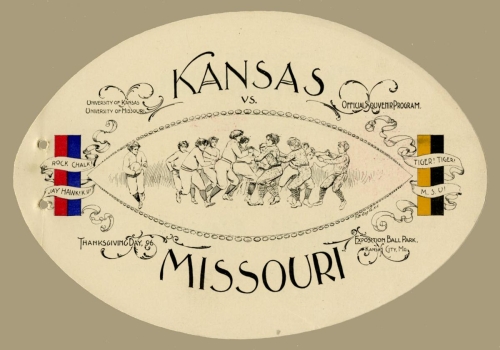How Football Started Coming to Thanksgiving Dinner in Kansas City

Tradition is the name of the game on Thanksgiving. Year after year, many families enjoy a holiday meal with the classics: cranberry sauce, mashed potatoes and gravy, turkey, and pumpkin pie, or their close cousins, the vegetarian or vegan options.
Friends and family might gather to watch the Macy’s Thanksgiving Day Parade, the National Dog Show, or A Charlie Brown Thanksgiving.
One grand Kansas City-specific tradition is the Plaza Lighting Ceremony, which many people can now ride to on the streetcar, creating a new tradition.
Then there’s football. The granddaddy of all Thanksgiving traditions—aside from eating turkey.
Last year, a record 141 million people watched at least one of the three NFL games—and those numbers might be higher this year.
But to understand how this game became such an integral part of the holiday, particularly in Kansas City, we have to look back more than a century.
The last Thursday of November 1863 marked the first official Thanksgiving holiday observed nationwide.
“(President) Abraham Lincoln promoted it as a national day of coming together,” says Special Collections Senior Librarian Michael Wells, “to build a tradition during the darkest days of the Civil War and to promote national unity.”

And, just as Thanksgiving was gaining a foothold in American life—so was football. In 1869, Rutgers University and Princeton University played the first recorded football game in the U.S.
A few decades later, in 1896, football and Thanksgiving came together in Kansas City, Missouri, when the Kansas Jayhawks and the Missouri Tigers played against each other on Thanksgiving Day.
The 2:30 p.m. kickoff was cold and rainy. Still, in an era that lacked a televised option, more than 5,000 fans sat outside to cheer for the teams. KU won 30-0 against MU.
The annual tradition continued at several venues in the Kansas City area—Exposition Park, Sportsman’s Park, League Park, and Association Park —until 1910. After that, the teams began alternating games between Columbia, Missouri, and Lawrence, Kansas.
Wells says that in those early days, football resembled rugby or soccer more than the game we know today.
“Different ball, no pads to speak of or very minimal padding, no passing,” he explains. “It was not considered a professional sport at all.”
For example, the forward pass was not added to the rules until 1906, introduced to address some of the safety concerns.
The Thanksgiving Day games in Kansas City would have kicked off the winter society scene as well, Wells says, since “the elites of society were the people going to college in those days. This was the 1890s, after all.”
Like now, students traveled home in droves from their respective universities on break. So, he adds, “This is sort of the beginning; everyone is coming together. There’s a celebration around the school, but, in addition to the regular Thanksgiving Day activities, there are certainly events going on in the city, gatherings and things like that.”
Wells says that these days, football and Thanksgiving naturally go together, and this connection has become a lasting part of American life.
“Even if people don’t particularly love the sport,” he says, “things like the background hum of a televised game, Lucy yanking the football away from Charlie Brown at the last second, or simply tossing a football around with family and friends — they’re all part of Thanksgiving now.”